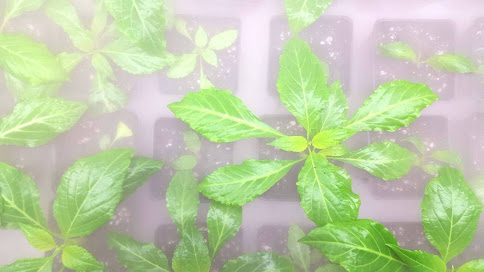How to Grow Salvia divinorum (Diviner’s Sage)

Salvia divinorum, commonly known as Diviner’s Sage, is a tropical perennial native to the cloud forests of the Sierra Mazateca in Oaxaca, Mexico. In its natural environment, the plant thrives in mild, humid conditions with filtered light beneath the forest canopy. To grow it successfully at home, it’s best to recreate those same environmental cues as closely as possible.
1. Maintain High Humidity

Salvia divinorum plants prefer humidity levels above 60%. If your enviorment is on the drier side humidity can be raised artificially using a greenhouse for outdoor plants or humidifiers coupled with small spaces like a grow tent for indoor plants...alternativly a shotgun terrarium can be implemented.
For a step-by-step shotgun terrarium build, see FreshCap's guide: How to build a Shotgun Fruiting Chamber (SGFC) — FreshCap .
If maintaining high humidity isn’t practical, the plant can be slowly acclimated to ambient indoor air. Expect older leaves to decline during the adjustment period, while new growth adapts. At Bounty Botanicals Plus, its not uncommon for our grow space to be around 30% humidity to give you an idea of what these plants are capable of adapting to.
2. Keep Temperatures mild
Ideal growing temperatures range from the mid-70s°F to low-80s°F (24–28°C). Avoid prolonged heat stress above 85°F or cold drafts below 60°F. Stable, moderate temperatures promote healthy leaf growth and strong root systems.
3. Provide Gentle, Filtered Light
In its native habitat, Salvia divinorum grows beneath the forest canopy, receiving bright but diffused light. Direct sun or intense lights may scorch the leaves. Indoors, LED or fluorescent lights with moderate output work well. Outdoors, select a shaded or partially shaded area. Although strong lighting can harm salvia plants, its important that they are not deprived either. Indications of too low light levels are small leaves and skinny, stemmy growth.
4. Use Rich, Well-Draining Soil
The best soil for Salvia divinorum is acidic (pH 5.5–6.5), high in organic matter, and loose enough for aeration. A high-quality potting mix blended with perlite provides excellent drainage. A 50/50 mix of Ocean Forest and Happy Frog with added perlite works beautifully, but any well draining, high quality potting soil should work.
5. Water Consistently—but Don’t Overdo It
Salvia divinorum prefers evenly moist soil but is sensitive to waterlogged conditions. Overwatering can suffocate roots, while underwatering causes leaf wilt. Instead of following a schedule, learn to gauge the soil’s moisture by touch: it should feel damp but never soggy.
- Note that environmental factors like temperature, light, and humidity will affect watering frequency.
6. Fertilize Lightly and Regularly
Use a mild, balanced liquid fertilizer (for example, a general-purpose 5-5-5 formula) during the growing season. Avoid overfertilizing — gentle, steady feeding supports healthy foliage without causing nutrient burn.
7. Avoid Root Binding
Root-bound Salvia plants tend to decline in vigor. Transplant regularly into slightly larger containers, or use breathable fabric pots that naturally air-prune roots and promote steady growth.
Summary: Key Growing Tips
- Humidity: 60%+ ideal; gradual acclimation possible.
- Temperature: 70–80°F range preferred.
- Light: Gentle, indirect, or filtered shade.
- Soil: Rich, airy, and slightly acidic.
- Water: Keep evenly moist, not soggy.
- Fertilizer: Mild and regularly applied.
- Container: Avoid root binding with periodic transplants or fabric pots.
Learn More
For additional information, explore our main Salvia divinorum page, shop live Salvia plants, or view our dry Salvia leaf specimens.
That’s about it, folks — happy growing!
